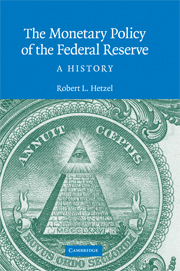Book contents
- Frontmatter
- Contents
- Figures
- Preface
- 1 The Pragmatic Evolution of the Monetary Standard
- 2 Learning and Policy Ambiguity
- 3 From Gold to Fiat Money
- 4 From World War II to the Accord
- 5 Martin and Lean-against-the-Wind
- 6 Inflation Is a Nonmonetary Phenomenon
- 7 The Start of the Great Inflation
- 8 Arthur Burns and Richard Nixon
- 9 Bretton Woods
- 10 Policy in the Ford Administration
- 11 Carter, Burns, and Miller
- 12 The Political Economy of Inflation
- 13 The Volcker Disinflation
- 14 Monetary Policy after the Disinflation
- 15 Greenspan's Move to Price Stability
- 16 International Bailouts and Moral Hazard
- 17 Monetary Policy Becomes Expansionary
- 18 Departing from the Standard Procedures
- 19 Boom and Bust: 1997 to 2001
- 20 Backing Off from Price Stability
- 21 The Volcker–Greenspan Regime
- 22 The Fed: Inflation Fighter or Inflation Creator?
- 23 The Stop–Go Laboratory
- 24 Stop–Go and Interest Rate Inertia
- 25 Monetary Nonneutrality in the Stop–Go Era
- 26 A Century of Monetary Experiments
- Appendix: Data Seen by FOMC for the Stop–Go Period Shown in Figures 24.1, 24.2, and 24.3
- Notes
- Bibliography
- Index
- Titles in the series
20 - Backing Off from Price Stability
Published online by Cambridge University Press: 26 May 2010
- Frontmatter
- Contents
- Figures
- Preface
- 1 The Pragmatic Evolution of the Monetary Standard
- 2 Learning and Policy Ambiguity
- 3 From Gold to Fiat Money
- 4 From World War II to the Accord
- 5 Martin and Lean-against-the-Wind
- 6 Inflation Is a Nonmonetary Phenomenon
- 7 The Start of the Great Inflation
- 8 Arthur Burns and Richard Nixon
- 9 Bretton Woods
- 10 Policy in the Ford Administration
- 11 Carter, Burns, and Miller
- 12 The Political Economy of Inflation
- 13 The Volcker Disinflation
- 14 Monetary Policy after the Disinflation
- 15 Greenspan's Move to Price Stability
- 16 International Bailouts and Moral Hazard
- 17 Monetary Policy Becomes Expansionary
- 18 Departing from the Standard Procedures
- 19 Boom and Bust: 1997 to 2001
- 20 Backing Off from Price Stability
- 21 The Volcker–Greenspan Regime
- 22 The Fed: Inflation Fighter or Inflation Creator?
- 23 The Stop–Go Laboratory
- 24 Stop–Go and Interest Rate Inertia
- 25 Monetary Nonneutrality in the Stop–Go Era
- 26 A Century of Monetary Experiments
- Appendix: Data Seen by FOMC for the Stop–Go Period Shown in Figures 24.1, 24.2, and 24.3
- Notes
- Bibliography
- Index
- Titles in the series
Summary
The characterization here of policy in the final Greenspan years is that the FOMC pursued its basic expected inflation/growth gap procedures but raised its implicit inflation target from price stability to low inflation. If that characterization is correct, the issue arises of whether there is a conflict between the twin objectives of “price stability” and “maximum employment” legislated in the Federal Reserve Act. Does achievement of “maximum employment” require secular depreciation of the currency, albeit at a low level? Does positive inflation “buy” stability of real output?
Raising the Implicit Inflation Objective
After the Asia crisis, the FOMC replaced its implicit long-run objective for price stability with an objective of low inflation (Chapter 17). Henceforth, the FOMC demonstrated an aversion to inflation as low as 1%. Figure 20.1 shows inflation compensation inferred from the difference in nominal and TIPS yields for the five-year interval, five years in the future. It measures the market's expectation of trend CPI inflation. Markets expected near-price stability in fall 1998. Over 1999, expected trend CPI inflation rose to 2.5%. The FOMC conveyed no message that this level of expected inflation exceeded its desired level for actual inflation.
Over 2000, expected trend CPI inflation drifted down and at year end reached 1.75%. In 2001, policy followed the basic lean-against-the-wind pattern. In 2001 as the recession became evident, the FOMC lowered the funds rate in an amount commensurate with its past responses to weakness (Figure 21.5).
- Type
- Chapter
- Information
- The Monetary Policy of the Federal ReserveA History, pp. 244 - 251Publisher: Cambridge University PressPrint publication year: 2008

